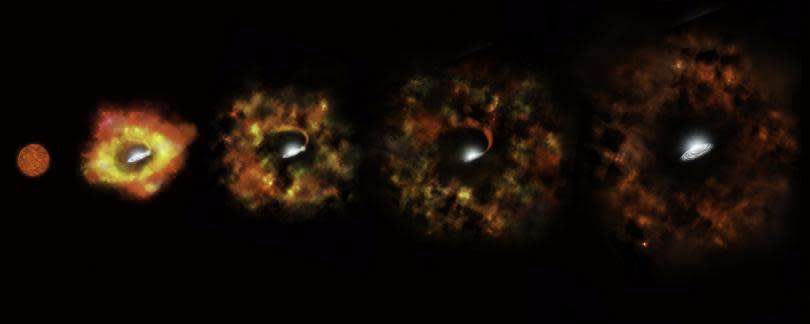Scientists Watch Star Collapse Into Black Hole
Scientists expected to see an enormous star explode in a supernova but they may have watched it collapse into a black hole instead.
NASA’s Goddard Space Flight Center said astronomers spotted something fishy with the Large Binocular Telescope in Arizona and the Hubble and Spitzer space telescopes when they trained the equipment in the direction of the star — or rather they didn’t spot anything; the star had simply disappeared. The space agency called it a “massive fail,” which may be especially true given that it resides in a galaxy that is nicknamed the “fireworks galaxy” because of the number of supernova explosions that occur there.
Read: Best Photos of Black Holes, the Universe’s Serial Killer
If the star, which is 22 million light years away, had exploded in a supernova, it would have turned into a black hole anyway. But this one transformed quietly, without a lot of fanfare.
“It went out with a whimper instead of a bang,” NASA said.
Supernovas happen with the biggest stars, which are usually old, and this one was 25 times more massive than the sun, in the “red supergiant” class. In such an event, the star’s massive core collapses under its own weight and implodes before the reaction bounces back outward and forces material into space, leaving behind a super dense object.
But the stellar explosions, the largest kind of space explosion, still happen rarely. This recent failure might confirm that stars don’t need to burst into a supernova to transform into a black hole and thus tell scientists more about why supernovas are so rare.

A massive star has disappeared, transforming into a black hole instead of blowing up in a supernova explosion. Photo: NASA/ESA/P. Jeffries (STScI)
“As many as 30 percent of such stars, it seems, may quietly collapse into black holes — no supernova required,” NASA said. And that makes sense when it comes to making the biggest black holes because the star would not have blown off so much material in an explosion, instead using that mass to power the black hole.
The scientists’ observations, as described in a study in the Monthly Notices of the Royal Astronomical Society, would mark the first time witnessing a star turn into a black hole and the first time catching a failed supernova.
Read: Is This a Black Hole or a Supernova?
Black holes got their name because they appear as dark voids in space. They are so dense that the force of their gravity is too intense for even light to escape, preventing any from reflecting and showing us what’s inside them. Any matter that comes too close gets shredded into atom-sized pieces as it is pulled into the black hole. And they are fairly common: Supermassive black holes lurk at the center of many galaxies, including the Milky Way.
Black holes are still mysterious objects, but we are getting closer to actually seeing one. An international team of astronomers announced earlier this year they think they captured the first-ever image of a black hole’s event horizon, the distance from the black hole that is the point of no return — where you cannot possibly escape its gravity. However, the scientists have not yet released their data.

A massive star disappeared from the night sky, collapsing into a black hole rather than exploding in a supernova. Photo: NASA/ESA/C. Kochanek (OSU)
Related Articles


